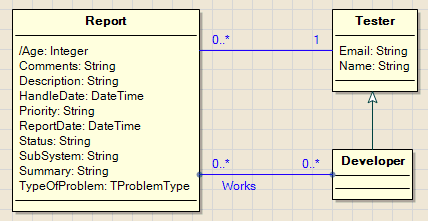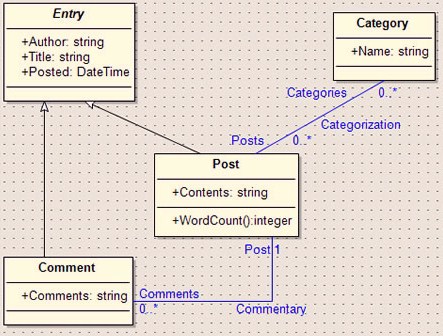
2011/10/31 - Delphi 2006 ASP.NET ECO Weblog
Delphi 2006 ASP.NET ECO Weblog is not a brand new book, in fact, it's using Borland Developer Studio 2006, but it is now available in a new eBook format from Barnes & Noble.
Delphi 2006 ASP.NET ECO III Weblog on Lulu.com
This 63-page courseware manual describes the design, implementation and deployment of my weblog, which was originally written using Delphi 2005 and ECO II, but is recreated from scratch using Delphi 2006 and ECO III. Full source code available, including ASP.NET AJAX enhancements.
The final deployed ASP.NET ECO weblog application has been in use for over two years now and has been used for hundreds of posts and comments.
This original version of the weblog has been enhanced several times in the past two years (for example with a comment spam filter) - enhancements which are not described in the manual (since the manual is about the design, implementation and deployment of the original, fully working, version of the weblog).
2006 August - The Delphi Magazine #132
My Under Construction column in the August issue of The Delphi Magazine is about Deploying ASP.NET / ECO III Applications.
In this article, I demonstrate how to deploy your ASP.NET applications (including the ECO III version of Bob's Error Report Tool) and untangles the various gotchas you may encounter along the way.
ECO III Case Study: Bob's Error Report Tool (BERT)
My Under Construction column in the May issue of The Delphi Magazine is about Enterprise Core Objects (ECO) III and State Machines.
Apart from States, I also cover Transitions between States using Triggers operations (and parameters for triggers), Guards (OCL Expressions, for example checking parameters or other preconditions), Effects (ECO Action Language statements), and Entry/Exit Actions of States.
ECO III Case Study: Bob's Error Report Tool (BERT)
My Under Construction column in the April issue of The Delphi Magazine is about Enterprise Core Objects (ECO) III.

In this article (part One of Two), I start to demonstrate the ECO III features in Delphi 2006, which are now brought down into the Professional Edition.
We'll design a model for Bob's Error Report Tool (BERT) in an ECO Package, make the model persistent, and create a simple WinForms GUI for it.
Next month, the ASP.NET Web version layer on top of the BERT ECO Package will be implemented and deployed.
NOTE: The complete source files from my previous Under Construction columns are now available from my UCCode Web Service, complete with Win32 client source code.
Enterprise Core Objects (ECO) ASP.NET Weblog
My ECO-driven weblog (ASP.NET) web application, as described in my article series for Bitwise Magazine, is finally deployed and made available online on my test server at http://www.drbob42.com/blog.
Feel free to read it and leave a comment if you wish.
RSS feeds have been added as well, including support for the ASP.NET Web Service on top of the ECO II model.
Future plans include the migration to Enterprise Core Objects III and the inclusion of State Machine support (to be included in my ECO III training manual).
I've written a number of articles about Enterprise Core Objects using Delphi for .NET.
The following articles are ordered in reverse chronological order (the oldest the bottom):
- Bitwise Magazine
Borland Developer Studio 2006 :: ECO III
- Bitwise Magazine
Blogging with Delphi 2005 and ECO II - #5
In the last part of the series on creating a weblog using ASP.NET and ECO II, I'll cover ECO Web Services and RSS feeds.
Next time, I will continue with Enterprise Core Objects III – trying to illustrate them using the existing example, as well as some new examples.
- Bitwise Magazine
Blogging with Delphi 2005 and ECO II - #4
Continuing our exploration of Delphi 2005 and ECO II to implement a web log application.
This time I'm dealing with the real-world deployment of the ASP.NET application.

- Bitwise Magazine
Blogging with Delphi 2005 and ECO II - #3
Continuing our exploration of Delphi 2005 and ECO II to implement a web log application.
This time I'm covering authentication and comments (among others).
- Bitwise Magazine
Blogging with Delphi 2005 and ECO II - #2 (ii)
Continuing our exploration of Delphi 2005 and ECO II to implement a web log application.
This second part covers the ASP.NET GUI on top of the ECO model.
- Bitwise Magazine
Blogging with Delphi 2005 and ECO II - #2 (i)
Continuing our exploration of Delphi 2005 and ECO II to implement a web log application.
This second part covers the ASP.NET GUI on top of the ECO model.
- Bitwise Magazine
Blogging with Delphi 2005 and ECO II - part #1
Delphi 2005 and Enterprise Core Objects (ECO) II can be used to define and implement an application handling web logs - also called blogs.
This first part defines the ECO model (see above) on top of the SQL Server database.
- Borland Developer Network
ECO II and ASP.NET Web Applications
This tutorial demonstrates the new capabilities of Enterprise Core Objects (ECO) II to be used in ASP.NET Web applications with Borland Delphi 2005.
- IBM DB2 Developerworks
IBM DB2 databases and ECO (Delphi 2005)
In this article I will use Borland Delphi 2005 and the Enterprise Core Objects (ECO) to import an IBM DB2 UDB database and create an UML object model for it, which is the bases for a .NET WinForms application. The object model (called EcoSpace) will use the IBM DB2 database as persistence layer, and can be used to connect to user controls (like DataGrids), offering drag-and-drop, autoforms (for individual items), save, undo, redo, etc. all on top of the IBM DB2 UDB database tables.
- IBM DB2 Developerworks
IBM DB2 databases with ECO and ASP.NET (Delphi 2005)
This article is a follow-up of the previous ECO article (which produced a WinForms application). This time, the result and focus is on an ASP.NET web application, while still using the IBM DB2 UDB database as basis for the imported EcoSpace, presenting the UML model of the data and generating ASP.NET web forms.
- IBM DB2 Developerworks
Using Delphi for .NET to design an object model for a DB2 database
This article demonstrates how to use the Architect edition of Borland Delphi 8 for the Microsoft .NET Framework, and specifically the functionality found in the Borland Enterprise Core Objects section, to design an Object Model that is made persistent inside the DB2 UDB SAMPLE database.
- Dr.Bob Examines...
Enterprise Core Objects
In this paper, I will explore the Enterprise Core Objects (ECO) of the Architect edition of Delphi 8 for .NET, covering the EcoSpace Object Model, UML (Unified Modeling Language), Classes, Attributes, Operations, Associations, Generalizations and Implementations, the PersistenceMapperXML, PersistenceMapperBdp, and Database Scripts.
ECO II is also covered in my Delphi 2005 courseware manuals (specifically the ADO.NET and ASP.NET titles), and the ECO II Weblog articles will be combined with the existing ECO coverage into a special ECO courseware manual later in 2005.


